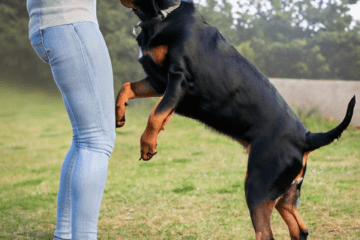 How does one really define biting? Is it engagement of teeth or is it to do with the intent behind the engagement of teeth?
How does one really define biting? Is it engagement of teeth or is it to do with the intent behind the engagement of teeth?
From what I had been told on the phone I was going to a dog that repeatedly bit people, especially the man, and I was expecting an aggressive dog.
That very day, the lady had told me, his biting had lost them his daycare.
When I arrived, at my request the one-year-old Beagle was wearing a soft muzzle with a lead attached to his harness. It was unnecessary. I sat down and the muzzle was removed. Benson was immediately all over me, much more interested in the food in my pocket than he was in me.
From when they first got him he was a very nippy/mouthy puppy. Unfortunately, instead of the mouthing being discouraged in an appropriate fashion from the start, it was unintentionally encouraged. Pushing him away and playing hand games was something the men did and until he got bigger it didn’t hurt too much. Loud squeals got him even more excited.
The older he grew, the more he used biting to get the attention he craved and the more it hurt.
As he gets ‘stuck in’, Benson quickly works himself up to a stage where he looses control of himself as his arousal levels simply overwhelm him. He then gets rough and frustrated. He will paw, hump and leap as high as a person’s head. Add to this the human response by way of confrontation, scolding and maybe shouting or grabbing him, he becomes a powder keg waiting to explode.
In a particularly highly aroused state this has, a couple of times, tipped him over into real aggression. Hence the loss of his daycare.
The couple’s life revolves around ‘fielding’ the jumping up, biting and pawing Benson throws at them. When he’s quiet they are so relieved to get some peace they understandably leave him alone. They have now resorted to muzzling him when he gets too much.
As the young dog is seldom offered attention when he’s being good and quiet lest they start him off again, what does this teach him?
The real challenge is that he’s now had nearly a year rehearsing and strengthening his biting skills. It’s become learned behaviour – a habit. It could be a difficult habit to break. The only way to achieve that is to do exactly the opposite to what has been done so far. They are now going to concentrate on teaching him the behaviour they DO want, reinforcing everything that pleases them (we started this with a clicker), pre-empt when possible and divert his attention if caught soon enough onto other items that he can freely chew.
There must be ZERO TOLERANCE for biting from now on. They have to do something to protect themselves from injury so this it’s very fortunatel he seems to like that muzzle and comes to put his nose into it without being asked. I believe it may act a bit like a calming band because he settles but without shutting down completely which wouldn’t be good.
He should not get away with even two or three bites before they react. NO bites are acceptable. Anything else just gives mixed messages.
At first feel of mouth or teeth they should immediately turn away and withdraw all interaction with him, looking away and ignoring him. At this point he may well begin a very loud bark. Having made it clear by turning away that they don’t want the bite, if he does it a second time the muzzle goes on with no fuss and no words.
Unlike previously, the muzzle should be left on only for as short a time as necessary and can come off again in five minutes or when his arousal levels have dropped sufficiently for them to give him something else to do.
Most importantly, we have made a list of rewarding activities with which they can punctuate their time with him in frequent short sessions which will use his brain or give him gentle exercise without hyping him up, rewarding him for being quiet or for exercising self-restraint instead of as it is at present with the great majority of the attention he receives generated by himself – rewarding and reinforcing his antics.
Basically, the young couple will be replacing the excitement he self-generates by biting, pawing, barking and sometimes humping with healthy stimulation generated by themselves. They will need to make liberal use of food.
They are prepared for this to take some time and a lot of patience! Dear little dog.


